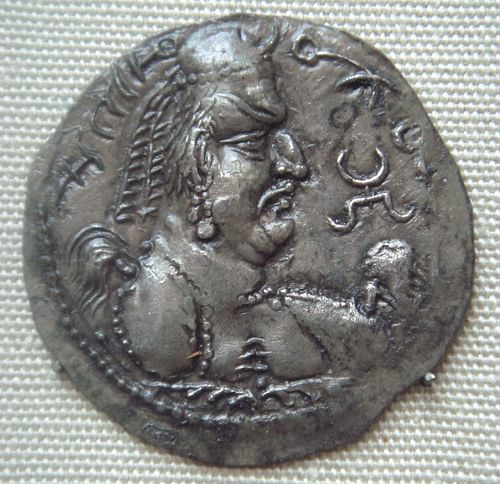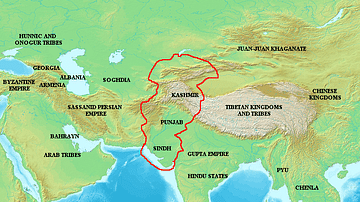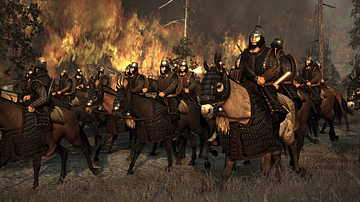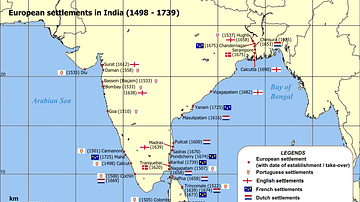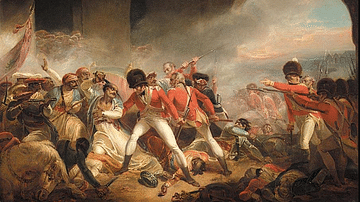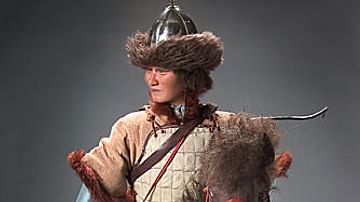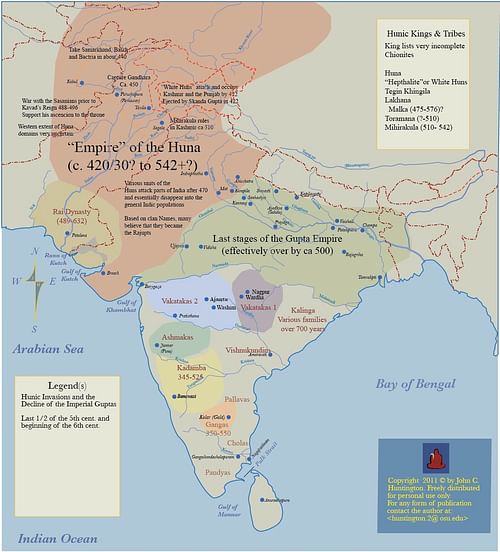
The White Huns were a race of largely nomadic peoples who were a part of the Hunnic tribes of Central Asia. They ruled over an expansive area stretching from the Central Asian lands all the way to the Western Indian Subcontinent. Although being a mostly nomadic tribe, they nonetheless adopted the lifestyles of the lands they conquered but still retained their warlike nature. Their rule begins in the 5th cent CE, but they lingered on in the region for a substantial amount of time after their kingdom fell and eventually integrated so well into the Indian culture that their practices and traditions became a full part of it.
origins of the White Huns
We cannot say with certainty which ethnic or racial group the White Huns belonged to but certain assumptions can be made about them. So far as their physical origins, in Litvinsky's History of Civilizations of Central Asia, there is mention of Chinese sources identifying them variously with either the Ch'e-shih of Turfan (now in the Uighur region of China), K'ang Chu or Kangju from southern Kazakhstan or the widespread Yueh Zhi tribes from Central China. These Yuehzhi were driven out of the Chinese territories that they occupied by another band of tribes known as the Hsiung Nu. One of these tribes of the Yueh Zhi was the White Huns or Hephthalites.
According to Richard Heli, Chinese chroniclers state that they were known as the Ye-ti-li-do, or Yeda but they are also known as the people of Hua by the same chroniclers. From these sources there is an ambiguity that arises which might show that something was lost in translation between the term Hua which converted to Hun instead and came to be associated with the Hunnic tribes.
The Japanese researcher Kazuo Enoki disregarded theories based solely on the similarity of names due to the fact that there is so much linguistic variation that we cannot say for certain that a particular name has not lost something in translation. His approach towards understanding the Hephthalite origins is to see where they were not in evidence instead of where they were. With this approach he has stated that their origins might have been from the Hsi-mo-ta-lo southwest of Badakshan near the Hindukush, a name which stands for snowplain or Himtala in modern times and this might be the Sanskritised form of Hephthal.
Of note here is the work of Professor Paul Harrison of Stanford University, who deciphered a copper scroll form Afghanistan in 2007 CE. The scroll is dated from 492-93 CE and is from the period of the Hephthalites. It apparently mentions that they were Buddhists and had Iranian names and includes about a dozen names including that of their overlord or King. Where their general name is concerned, they have been variously known as Sveta Hunas or Khidaritas in Sanskrit, Ephtalites or Hephthalites in Greek, Haitals in Armenian, Heaitels in Arabic and Persian, Abdeles by the Byzantine historian Theophylactos Simocattes, while the Chinese name them the Ye-ta-li-to, after their first major ruler Ye-tha or Hephtal.
The variety of names shows that there is ambiguity towards the specific identity of this particular race and that historically they do not have a set origin that defines them separately from the various other tribes that existed within that region at the same time, mostly of nomadic origins. The Chinese writer Wei Chieh has stated that despite these claims, we cannot be certain of their authenticity as the information has come from remote countries and in languages which have lost much meaning in translation, so it is impossible to find the origins of the Hephthalites in these accounts.
There is an interesting definition of their origins that has also been proposed. Up to now it has been considered that they were called the "white" huns due to their skin colour. However this is apparently not the case, as the various Hunnic tribes had long ago divided themselves into four groups along the cardinal points, each with a specific colour. The Northern Huns hence became the "Black" Huns, the "White" Huns were the western tribes, the "Green" or "Blue" were the southern and the "Red" Huns occupied the Eastern territories. So despite being identified as fair skinned, the name itself has less to do with physical appearance and more to do with their self-devised methods of tribal affiliation.
Territory & General Customs
Procopius of Caesarea (6th cent CE) is quoted multiple times across publications as giving the first physical descriptions of these people and their society in the following words:
“The Ephthalitae are of the stock of the Huns in fact as well as in name; however, they do not mingle with any of the Huns known to us, for they occupy a land neither adjoining nor even very near to them; but their territory lies immediately to the north of Persia; indeed their city, called Gorgo, is located over against the Persian frontier, and is consequently the centre of frequent contests concerning boundary lines between the two peoples. For they are not nomads like the other Hunnic peoples, but for a long time have been established in a goodly land. As a result of this they have never made any incursion into the Roman territory except in company with the Median army. They are the only ones among the Huns who have white bodies and countenances which are not ugly. It is also true that their manner of living is unlike that of their kinsmen, nor do they live a savage life as they do; but they are ruled by one king, and since they possess a lawful constitution, they observe right and justice in their dealings both with one another and with their neighbours, in no degree less than the Romans and the Persians.”
- Procopius of Caesarea (Book I. ch. 3),
They acknowledged a single king, were not divided into tribes, had a proper constitution for everyday governance, and were considered just and fair by their neighbours. Their burial systems were also different from the well-known European and Chionite Huns as they buried their leaders in mounds of earth and stone with the companions who served them in life, showing also a different funerary culture and possibly different religious beliefs.
Beginnings of White Hun Invasions into India
The White Huns emerged, then, in the region of Transoxiana in the late 3rd century CE and by the beginning of the 4th century CE they had occupied the regions of Tokharistan and Bactria (Northern Afghanistan). This group of people was exceedingly warlike, and ever since their emergence they rapidly conquered the territories south of their lands of origin.
Most researchers are of the mind that the White Huns were also joined and bolstered in number by the Chionites in Transoxiana, as these two tribes were related. Still other scholars think that these White Huns were descendants of the Kushan dynasty, as they called themselves "Shahan-Shahis", like the Kushans did, on the coins that have been found from the period. In fact in most Indian sources, no distinction has been made between the Kushans, Kidarites and the Huns overall, so confusion remains as to who exactly the ancient sources such as the Puranas referred to when they talked of the "Hunas".
Whatever the case may be, what we do know is that the period during which the Hephthalites are said to have been warring for control of this region was a time of general tumult in the subcontinent and adjoining areas. At this time, simultaneously, the Sassanians were at war with the Kushans (or Sakas, Kidarites or Hephthalites, as their identities are described differently in various sources), who themselves were busy with internal problems, not to mention trying to hold on to territories in the east which were being contested by the Guptas at the time.
The Guptas finally decisively opposed the Kidarites and defeated them, sending them back into their strongholds in the Punjab around 460 BCE. At this point the Kidarites themselves were usurped from their seats of power by the incoming Hephthalites, yet another tribe from the same stock as them that nonetheless strove to establish their rule over territories held previously by their rivals.
It was around 470 CE that White Hun raids into India are said to have begun or at least reached a high point, when the Gupta king Skandagupta died. The Tegin (or governor) Khingila is said to have led these raids into India, taking Gandhara from the Kidarites in 475 CE. After this they descended from the Kabul valley into Punjab, sacking towns and cities until they reached the seat of Gupta power in Pataliputra.
white hun rulers
Before detailing the rulers of the Indian Empire of the White Huns, a distinction should be made about what their role exactly was. The first king of the White huns in India is known by the name Tunjina or Khingila. However this name comes with a title of "Tegin" as well. This title denotes governor or warlord. However there is an entirely different title of the Kagan that is given to the overlord of the White Huns, whose seat is said to be near Bukhara. Evidence suggests that the White Huns who came into India were, although of the same lineage, different in terms of their ruling dynasty and established an outlying independent kingdom in India which was working in tandem with the wider territories in Central Asia. As such, the White Huns can be divided into the Hunas of India, and the Hephthalites of Central Asia. Although they retained separate rule, they nonetheless remained in contact and in alliance, aiding each other militarily when required.
List of Rulers
The rulers concerned with here are those of the Indo-Hunas, as they are most closely related to our main subject of the Gandhara region. Various lineages are given in places, but most scholars seem to agree on the following chronology:
- Tunjina (Khingila); The first to initiate Indian invasions. 455-484 CE
- Toramana; Son of Tunjina. 484-515 CE
- Mihirakula; Son of Toramana. 515-533 CE
- Pravarasena; Youngest half-brother of Mihirakula. 537-597 CE
- Gokarna; Son of Pravarasena
- Khinkhila; Son of Gokarna. 600 and 633 CE
- Yudhishthira/Judhishthira; Son of Khinkhila. 633 to 657 CE.
- Lakhana; Son of Yudhishthira. 657 - 670 CE
In Lakhana's time the White Huns retreated to Ghazni via the Peshawar valley. Ahmad Hasan Dani has been cited as naming Yudhishthira as the last king for this reason, as in Lakhana's time the Hunas had been routed as an Empire. It is at this time that Hephthalite rule in India is taken to have ended after nearly 20 years of fighting.
The last hunnic king of the Indo-Huna tribes is known as Purvaditya ruling from around after 670 CE. It should be mentioned that these kings were of a very later time and were probably overlords of a very small region as compared to their predecessors.
These regions were Hun "Mandalas" or centers and existed for a long time even after the main Empire collapsed. Malwa, Madhya Pradesh, Rajasthan and East Gujrat are known Huna centers in India.
The Garuda Pillar mentions defeat of the Hunas by the king for which it was erected, and is dated to 850 CE, showing the continued existence of White Hun descendants in the region. Even later evidence is present in the Atpru inscription which mentions the ruler of Medapatta marrying a Hun Mandala king's daughter, dated to 977 CE.
Much other evidence is given as to the extent in which Huns spread in India and moreover they are said to be the ancestors of many local tribes of the region such as the Rajputs, Gujars and Jats and also the Abdalis, Karluks and Khalachs in Afghanistan and Central Asia .
This was pretty much a custom in India at the time, where conquerors would gradually assimilate into the native population and integrate with the people, sometimes even being converted into castes themselves as happened with the Gujars who became "royal shepherds" of the Kashatrya caste and the Jats who became brave fighters and later gave rise to another warrior group, the Sikhs. The Rajputs themselves retained their warlike abilities and were later on initiated into the Hindu religion as a caste. Aradi states through various references that this was owing to the fact that the Brahmin caste saw the use of integrating these formidable people into the fold of Hinduism and hence initiated them through a special ceremony in the 7th Century CE. Their roots are still evident in their music and warrior background.
Important Rulers of The Indo-Huna Empire
Although there are many rulers in the long line of succession of the Hephthalites, only the more important ones arfe discussed, those who were ruling the larger, more powerful empire, at the beginning rather than small principalities or city states as in later times.
Toramana
Our first mention of Toramana comes from the region of Madhya Pardesh in India where an inscription proclaims him Maharajadhiraja (the King of Kings). Another inscription on the Kura main pillar in the small town of Kura in Punjab, Pakistan also mentioned "Maharajadhiraja Shri Toramana", showing that he ruled at least from middle India into Punjab during the 5th Century CE to which these inscriptions have been dated. The third mention comes from the Gwalior inscription but this was made during the reign of his heir, Mihirakula. The inscription also has the exact date it was made, that being the 15th year of Mihirakula's reign telling us that Toramana ruled from 484-515 CE. This inscription even mentions the religion of father and son, being a part of the Shivite sect of Hinduism.
There is also numismatic evidence concerning the reign of Toramana and the extent of his kingdom which shows that his kingdom extended from Bactria, Eastern Iran and all the way to half the lands of the Indian subcontinent. His reign was significant enough that coins from his time were still being used in the 18th century CE in the bazars of Kashmir. Although it is known from some numismatic evidence that the original religion of the Hephthalites was Sun Worship, they had adopted the Shivite practices by the time they established themselves in Gandhara showing the ability to conform or adapt to the prevailing conditions rather than being rigid in their ideologies.
In terms of physical strength, Toramana is considered to be only second to Atilla the Hun, well known as the scourge of Europe during the same era, as having established the Huns in a viable home state and as a powerful dynasty, with a territorial extent from Central Asia to Central India. He re-organized the various disparate tribes into a cohesive whole with a well-structured army and governmental system, having two seats of power; one in the North in Kabul and Purushapura and one in the South of India in Malwa (present day Rajasthan and Madhya Pradesh). It was due to his highly structured system of governance and rule that people accepted him, as he was very accommodating towards conquered peoples and was not needlessly oppressive or unjust. This allowed him to rule over a large area and gave the White Huns and the tribes who joined them the status of a Nation for the better part of a century.
Mihirakula
Although he is considered a great ruler in terms of military conquests for the Hephthalite Empire, Mihirakula is not remembered the same way his father was. He is thought to have been a harsh and cruel ruler who was not loved at all by his subjects, and is considered the reason why the Huna name was feared and eventually opposed in the subcontinent by local rulers. He is mentioned with his father in the Gwalior inscription of 530 CE and only three years later he is mentioned in the Mandasor inscription of 533 CE which recounts his defeat by the tribal prince Yasodharman showing the quick decline of his power.
Further evidence of his reign is found in coins, found all through Bactria and Kashmir and parts of India which at various times show images of the Sun God, Ahura Mazda of the Zoroastrians or the Trident of Shiva showing that although the ruler was the same, the areas under Hephthalite control had their own regionally dominant religions despite the rulers being inclined one way or the other. Mention of him by the Chinese pilgrim Sun Yung who came to Kashmir while he was ruling there makes him out to be a very cruel and arrogant ruler, as he did not pay due respect to the Chinese Emperor by standing up when his letter was read, but instead said "why should I pay respect to a piece of paper?".
Although known as a great warrior and military leader, he was also considered a fanatical ruler who kept control by any means. A Greek missionary, Cosmas Indicopleustes, who sailed to India in 530 CE, wrote about his military strength, describing 2000 elephants and a large cavalry. He told of the ransoms (or tributes) taken from territories not under Mihirakula's command. His name is written as Gollas which points to a different pronunciation of the second part of his name, "kula" or "gula".
Evidence of his cruelty is given in the Kashmiri historical chronicle the Rajatanagini, where it is described how he persecuted the Buddhists and strictly followed Shivite Hinduism. He even built a temple in Kashmir while residing there for the worship of Shiva. His troops were said to have destroyed 1400 monasteries in central Gandhara, Kashmir and the Northwestern Subcontinent, the areas where he had the most solid rule. Remoter areas such as Mardan and Swat were spared as they were not easily accessible and were consequently left a certain degree of autonomy. Strangely enough before his persecution he was actually interested in the religion.
After his defeat in 533 CE by Yasodharman in the West, Mihirakula tried to consolidate his power in the East of his Empire around Patna, but was defeated by the king Baladitya there, who being a Buddhist did not kill Mihirakula, who then withdrew to Kashmir. He eventually ascended the Kashmiri throne through guile and deceit but did not manage to keep power for too long, dying in 533 CE of disease. While in Kashmir, he reformed his forces and attacked the Gandhara region again, killing the entire royal family there and burning Buddhist temples and stupas. He also massacred half the people there who were of Buddhist faith.
Pravarsena
He was the younger son of Toramana by another wife, and was vehemently opposed by his half-brother Mihirakula, for which reason he was hidden away after Toramana died and remained in the North of India as a pilgrim until the death of his brother. Then he ascended the Kashmiri throne in either 533 or 537 CE at the age of 25. He is known to have ruled for 60 years up until 597 CE and was considered to be a strong and loyal ally who was accepted by his subjects, unlike his predecessor. He is also considered to have founded Srinagar in Kashmir and raised a temple near the city for the worship of Shiva.
It is during Pravarsena's reign that we see evidence of the use of the word "deer" with reference to the Huns, which is a symbol used throughout history and mentioned by a court poet. Furthermore, from numismatic evidence we know that the Hephthalite strongholds were the same as before, namely Kashmir, North-Western Punjab, Southern Bactria and Gandhara. On these coins we also see the honorific "Kidara" along with the name of the king in places such as Kashmir, showing that the White Huns were trying to prove their ancient Kushan roots in order to cement their rule.
Society and Culture
Lifestyle
Although initially nomads who moved from pasture to pasture and between cold and warm climates, the Hephthalites finally settled into various cities after they established their rule over the subcontinent and central Asia. Initial accounts by Chinese pilgrims describe their nomadic lifestyle, telling of how they moved entire populations to new areas along with the king and his entire court but later writings state how they had settled into well-defended and populated cities all across the conquered regions. There was also a marked class difference between the elite and common people, with the elite obviously enjoying the best of the produce and luxuries and the common people relegated to menial tasks much like any other society.
Religious Practices
Chinese pilgrims, namely Sung Yun, give evidence of the religion of the Hephthalites, specifically in Gandhara, as that of fire worship, although overall they are said to be following heathen, foreign or demon gods. The idea of fire worship or sun worship, although not unusual in that time of history, still allows us to connect the Hephthalites with an Iranian origin i.e. early Zoroastrian religion, which further gives credence to the ideas of Enoki that the White Huns are of Iranian origin and not Huns at all (Heli, 2007) and these were later integrated into Hinduism as well.
Burial customs are said to have been similar to other hunnic or mongoloid tribes, with a stone cairn raised to house the tomb and a pit to hold the coffin, which was sometimes of wood. Goods were also laid in the tomb with the person who had died, specifically those he had used in his lifetime. The Central Asian White Huns also entombed slaves or close friends of the dead person within the tomb as well. When a parent died the child would cut off one ear. These burials also give us a contradiction with Zoroastrianism where dead bodies are left in the open, but may prove to be a sundered branch of Iranian tribes who had adopted local Central Asian customs. Their burial practices also puts them at odds with ideas of Turkish origins.
Polyandry is a well-documented aspect of their lifestyles, where one woman was married to many brothers with the oldest brother said to be the father of any children she might have. Headdresses were worn with horns, and their numbers indicated how many husbands the woman wearing them had.
Buddhism at this time is said to have been roughly of the same development pattern as before but gradually the Hephthalite rulers started to discriminate against it, perhaps owing to the increase of other religions amongst their subjects which threatened to overcome their ideologies. This might also be why they at first tried to integrate with the populations religiously by minting various coins but later on went wholly against Buddhism and perhaps even other religions like Manichaeism and the newly arrived Christianity. However, their tolerance and continued adherence of Buddhism is seen well into the 6th century CE and only begins to decline after the Hephthalites were removed from power in the subcontinent, showing that it was the subsequent Hindu dynasties that were the real reason behind the later decline of Buddhism.
In all texts a point has been made that the region of Gandhara was considered to be a hub of all the religions of the region and was extremely tolerant in nature. Hindus, Zoroastrians, Persian followers of Mithra, and Ardoksho are all said to have existed here and accepted initially by the White Huns which, as already mentioned, is evident in their coins and inscriptions.
With regards to Buddhism (which relied on travelling monks and trade revenue along with compliant rulers to flourish) there was also an upsurge in India in Puranic Hinduism teachings during the reign of the Guptas. These teachings revolved around resurgent Hindu teachings which were based on the newly composed Puranas. It was during this time, through the written laws of Hinduism (not in evidence before this time), that the ruling classes sought to establish their undisputed rule in the subcontinent. This harsh division of the social order went pretty much against the entire Buddhist and Jain philosophies, and coupled with a surge in conquests by the Guptas based on religious philosophies of a pan-Indian empire; this led to an overall state backed rejection of other religions. In the Pre-Gupta period, other religions like Jainism and Buddhism were able to develop themselves more fully as they were not threatened by a religious philosophy that was seeking to entrench itself into the region.
Language
Many theories have been proposed as to the language of the Hephthalites, but no conclusive proof has been found. Turkic and various Indo-Iranian are some proposed languages but there is enough proof to tell us that different regions controlled by the Hephthalites were under the influence of different languages such as Bactrian, Pahlavi, Sogdian amongst others along with many scripts as well such as Bactrian, Kharoshti, Brahmi and Pahlavi.
What can be said for sure is that the Bactrian language was the official language of the Hephthalites which itself was a development of the Greek script. The script is considered very difficult to read, and only a few examples of it have been found, which are not indicative of the large amounts of material that Hsuan-Tsang, the Chinese pilgrim, has written about. Furthermore the Chinese chronicle Pei-shih states that "Their language differs from that of the Juan-Juan (Mongoloid), Kao-che and various Hu (Turkic tribes)" (Silk Road Foundation) with a similar account presented by Wei Shu (Book of Wei). The "Hu" language refers to that of the Iranian speaking people of Central Asia, whom the Chinese called Hu. From later accounts by the Chinese Pilgrim Xuang Zang, we can understand that their language was of Bactrian origin with a Greek base and still in use up to the 8th century CE.
Towns & Villages
Although outnumbered by rural settlements, urban centres of the Hephthalites were nonetheless very important for administrative and trade purposes. The towns were built in two parts; a citadel and an urban town both of which were highly fortified and built with mudbricks and beaten clay. Our most clear understanding of these comes from the Chinese pilgrims mainly Hsuan-Tsung. He writes of the largest known city being that of Balkh, which is said to have had strong fortifications but a thin population. It had 100 monasteries which housed 3000 monks with a large monastery outside the town as well.
Termez was another centre described by Hsuan-Tsung which was said to be of the same size as Balkh, approximately 70 ha. It had 10 monasteries and about 1000 monks and had a central town and a suburb area enclosed by a wall with a possible citadel.
Conclusion
From all the research studied we can discern that the White Huns are in fact a very problematic people. They are problematic in that everything from their origins, their religion, their customs, names, tribal affiliations etc. are all under dispute or merged so closely with those of other similar groups, that pinpointing a neat boundary that we can conclusively say is wholly White Hun is not an easy prospect. This is coupled with the obvious ability of these people to fully integrate with the conquered regions that further blurs the lines between the rulers and the ruled and only gives us isolated references to them. The significant problem in sources which variously either group them together with other nomadic hordes or distinguishes them fully also makes it difficult to ascertain the bounds that this group occupied.
Nonetheless, whoever they were, ample evidence still exists to tell us that their influence within this region was fast and brutal and perhaps not in the negative sense. It was brutal in that in very little time they managed to seep very deeply into the Indian subcontinent, adopting religions, customs, cities and even states as their homes. They shunned their previous nomadic lives and slowly become so much a part of the fabric of Indian society that even today cities and towns bearing their names exist in the form of Hunavasa, Hunaganva Hunajunmu, Madarya, Kemri in the Indian provinces where they found permanent homes for themselves. So despite the limited time that they ruled, they managed to deeply burrow into this region and left a legacy that persists to this day.
